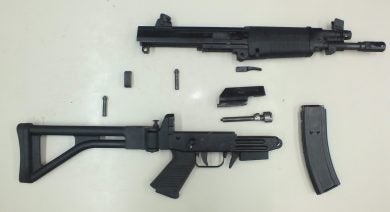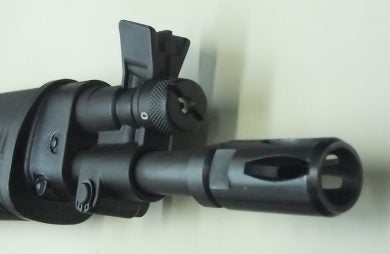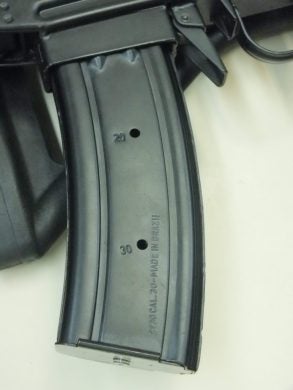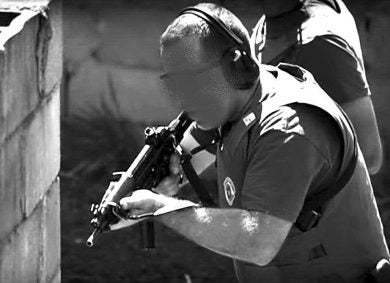Following the collaborative program with Chile’s FAMAE – Fábricas y Maestranzas del Ejército covering the manufacture and sales of the MT40/MT9 submachine guns and the CT40 carbine in Brazil, Forjas Taurus was still to try an additional – and final – venture with that State-owned company. The resulting weapon was another direct descendant of the Swiss SG 540/542/543 family of military rifles, whose full design and production technical material, plus machinery and tooling, were available to the Chileans. It was just a matter of (short) time until they came out with a semi-auto carbine chambered to the .30M1 round (7.62x33mm), a weapon that appeared to adequately fit the requirements of some Brazilian LE agencies seriously considering the use of that intermediate cartridge at that time.

With the stock folded to the right side, the gun’s length was reduced from 810 to 560mm in this flash hider-equipped example. The more common, plain barrel model was 25mm shorter and 65g lighter.
The resulting weapon, designated CT30 for obvious reasons (Carabina Taurus .30-caliber), could immediately be linked to the SIG/FAMAE weapons since it used a similar lower receiver/trigger/pistol grip assembly, hand guards, sights, etc. A conventional gas piston action was employed, with the gas regulator (0-1-2 settings) being located just ahead the front sight assembly. Dedicated, all-steel 15- and 30-round magazines were available, the larger capacity models being generally preferred by users.


Exploded-view drawing of the Taurus-FAMAE CT30, and the gun field stripped for basic maintenance.
As expected, orders did come by around 2008, as those from Military and Civil Police agencies of the Espirito Santo, Rio de Janeiro, Rio Grande do Sul, Sergipe, Santa Catarina, São Paulo, and Tocantins States, for example, the weapons being gradually introduced into service… with mixed results. Complaints originated mainly from Rio de Janeiro, including such mishaps as feeding/ejection failures, having a non-rigid (prone to loosening) front sight/gas regulator assembly, “parts that flew away” (I heard this during article research!), etc. I have also been told that a major design concern was the result of a very original Swiss requirement: the trigger guard was made to fold to the left side so as to allow firing the weapon while wearing heavy gloves. Obviously, this was hardly a scenario for tropical Brazil, but there were recorded events that led to accidental carbine discharges when triggers were left unguarded and hit things. Sure, weapons had to be in the safety-off status, but you know how creative Murphy is!

The business end of the CT30 carbine with the optional flash hider. Gas regulator (in the “1” or “normal” position) is seen below the protected (V-shaped ears) front sight.

The front and rear sights offered a radius of 350mm. The rotating drum rear unit is seen here in the 50-meter, U-shaped setting, apertures for 100 and 150 meters being also provided.

CT30_06A:
The dedicated 30-round magazine. Note the blade-type release lever aft of the short magazine housing.

Left side view showing the fire selector lever (duplicated on the right side), the foldable trigger guard, and the magazine release blade.
It just so happened that different operation and firing incidents with the CT30 led to disputes with Forjas Taurus, more so, in the case of the guns supplied to the Rio de Janeiro State Police. Several requested modifications to the weapons were not made, the Brazilian manufacturer reportedly arguing that the agreement in effect with FAMAE did not allow alterations to the original design. Several batches of CT30s were sent to the Porto Alegre, Rio Grande do Sul State, facilities of Taurus for repairs, but results were next to non-existent. It was finally decided to ship back the remaining 1,100-or-so guns in the combined PMERJ (Military Police) and PCERJ (Civil Police) inventory in a final attempt to solve the problems, or even manage to get a refund. Looks like neither eventually succeeded, but the money paid was later used in the acquisition of .40 S&W CTT40 semi-auto carbines, the subject of our next article.

Two Taurus-FAMAE CT30s photographed in actual urban combat use by PMERJ (Polícia Militar do Estado do Rio de Janeiro), in November, 2010. The weapon, however, soon became untrustworthy by the troops, a major problem for any weapon.

A CT30 in range use by a PMESP (Polícia Militar do Estado de São Paulo) agent, no flash hider fitted.

These two CT30s show that weapons were available both with and without a flash hider.
A short video showing the Taurus-FAMAE CT30 carbine:
https://www.youtube.com/watch?v=4xGEO8XW5ls
Hi-res pics? https://imgur.com/a/RzD8W
 Your Privacy Choices
Your Privacy Choices
